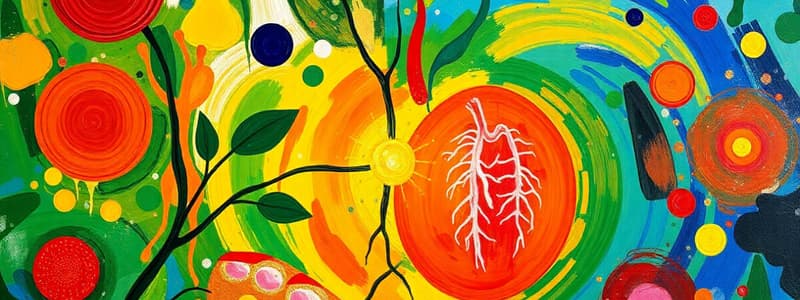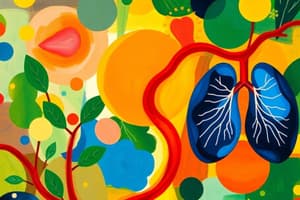Podcast
Questions and Answers
What is the main end product of lactic acid fermentation in muscle cells?
What is the main end product of lactic acid fermentation in muscle cells?
- Acetic Acid
- Carbon Dioxide
- Ethanol
- Lactate (correct)
What role does NADH play during lactic acid fermentation?
What role does NADH play during lactic acid fermentation?
- It is oxidized to NAD+. (correct)
- It is converted into glucose.
- It is utilized to create energy.
- It is reduced to ethanol.
In alcohol fermentation, pyruvate is converted into which two substances?
In alcohol fermentation, pyruvate is converted into which two substances?
- Lactate and Oxygen
- Acetic Acid and Ethanol
- Glucose and Lactate
- Ethanol and Carbon Dioxide (correct)
Which of the following is true about obligate anaerobes?
Which of the following is true about obligate anaerobes?
What happens to yeast when the alcohol concentration in wine reaches around 14%?
What happens to yeast when the alcohol concentration in wine reaches around 14%?
What is the primary purpose of cellular respiration?
What is the primary purpose of cellular respiration?
Which of the following best describes the relationship between breathing and cellular respiration?
Which of the following best describes the relationship between breathing and cellular respiration?
During cellular respiration, which of the following occurs?
During cellular respiration, which of the following occurs?
How much ATP can be produced from one molecule of glucose during cellular respiration?
How much ATP can be produced from one molecule of glucose during cellular respiration?
What percentage of the total energy available in glucose is stored as ATP during cellular respiration?
What percentage of the total energy available in glucose is stored as ATP during cellular respiration?
What is the role of hydrogen during the process of cellular respiration?
What is the role of hydrogen during the process of cellular respiration?
What effect does retinone have on the electron transport chain?
What effect does retinone have on the electron transport chain?
What happens to the electrons during the breakdown of glucose?
What happens to the electrons during the breakdown of glucose?
Which process uses the energy from light to produce glucose?
Which process uses the energy from light to produce glucose?
Which poison blocks the flow of protons through the ATP synthase channel?
Which poison blocks the flow of protons through the ATP synthase channel?
Which statement best explains oxidation in the context of cellular respiration?
Which statement best explains oxidation in the context of cellular respiration?
How many ATP molecules are typically produced from one NADH during oxidative phosphorylation?
How many ATP molecules are typically produced from one NADH during oxidative phosphorylation?
What is the primary role of oxygen in oxidative phosphorylation?
What is the primary role of oxygen in oxidative phosphorylation?
Which poison acts as an uncoupler in the electron transport chain?
Which poison acts as an uncoupler in the electron transport chain?
What is the maximum ATP yield from glycolysis?
What is the maximum ATP yield from glycolysis?
Which of the following statements about fermentation is true?
Which of the following statements about fermentation is true?
What happens if oxygen is not present during cellular respiration?
What happens if oxygen is not present during cellular respiration?
Which statement correctly describes the contribution of FADH2 in ATP production?
Which statement correctly describes the contribution of FADH2 in ATP production?
What is the primary energy transformation that occurs in the citric acid cycle?
What is the primary energy transformation that occurs in the citric acid cycle?
What process is used to generate ATP during oxidative phosphorylation?
What process is used to generate ATP during oxidative phosphorylation?
What is the end product of glycolysis?
What is the end product of glycolysis?
Which molecules bring electrons to the electron transport chain?
Which molecules bring electrons to the electron transport chain?
What occurs as electrons move down the electron transport chain?
What occurs as electrons move down the electron transport chain?
What happens to the energy released from the breakdown of glucose during glycolysis?
What happens to the energy released from the breakdown of glucose during glycolysis?
What causes the H+ gradient in the mitochondria during oxidative phosphorylation?
What causes the H+ gradient in the mitochondria during oxidative phosphorylation?
What is substrate-level phosphorylation?
What is substrate-level phosphorylation?
Which enzyme-catalyzed reactions occur during glycolysis?
Which enzyme-catalyzed reactions occur during glycolysis?
After glycolysis, what happens to the pyruvate molecules?
After glycolysis, what happens to the pyruvate molecules?
How much ATP is generated from glycolysis?
How much ATP is generated from glycolysis?
Which of the following statements about ancient prokaryotic cells is true?
Which of the following statements about ancient prokaryotic cells is true?
What are the initial products when fats are broken down for energy?
What are the initial products when fats are broken down for energy?
During the process of protein digestion, what happens to the unused amino acids?
During the process of protein digestion, what happens to the unused amino acids?
What is the primary reason that glucose is not commonly found in our diet?
What is the primary reason that glucose is not commonly found in our diet?
How does feedback inhibition function in cellular biosynthesis?
How does feedback inhibition function in cellular biosynthesis?
What is the relationship between glycolysis and the citric acid cycle?
What is the relationship between glycolysis and the citric acid cycle?
Which of the following organic molecules can be processed to generate ATP?
Which of the following organic molecules can be processed to generate ATP?
What role do hydrolytic enzymes play in starch breakdown?
What role do hydrolytic enzymes play in starch breakdown?
Why can animal cells not generate sugars from CO2 and H2O?
Why can animal cells not generate sugars from CO2 and H2O?
Study Notes
Energy Requirements
- Cells require energy to perform essential functions like growth, reproduction, material transport, movement, and maintaining structure.
- Photosynthesis is the process that converts light energy from the sun into chemical energy stored in glucose and oxygen.
- Organisms that conduct photosynthesis include bacteria, plants, and algae.
Cellular Respiration
- Cellular respiration breaks down glucose and oxygen, produced by photosynthesis, to generate carbon dioxide and water.
- It stores chemical energy in the form of ATP.
- A small amount of energy is lost as heat during these conversions.
Breathing and Cellular Respiration
-
Breathing provides the oxygen needed for cellular respiration.
-
Respiration is the exchange of gases, where organisms obtain oxygen from their environment and release carbon dioxide as waste.
-
It is also defined as the aerobic harvesting of energy from food molecules by cells, distinguishing it from simply ‘breathing’.
-
Oxygen taken in during breathing enters the bloodstream and travels to all body cells, particularly muscle cells during physical activity.
-
These muscle cells utilize the oxygen in their mitochondria to generate ATP through cellular respiration.
-
This process provides the energy for muscle contraction and carbon dioxide is released as a waste product.
ATP as Energy Storage
-
Cellular respiration primarily generates ATP for cellular functions.
-
Glucose is a common energy source, but other organic molecules can also be utilized.
-
Energy is released as chemical bonds in glucose and oxygen break and reform into carbon dioxide and water.
-
This released energy is captured and stored in ATP.
-
Cellular respiration can produce up to 32 ATP molecules from a single glucose molecule.
-
The generated ATP represents only ~40% of the total energy available in a glucose molecule.
-
The remaining energy is lost as heat.
Bodily Functions that Utilize ATP
- Breathing, maintaining a heartbeat, and regulating body temperature at 37°C require a constant supply of ATP.
- Brain cells require an exceptional amount of energy, consuming about 120 grams of glucose per day and utilizing 15% of the body's total oxygen.
- Approximately 75% of the total energy taken in each day is used to maintain basic life functions.
- Voluntary activities, such as physical movement, are also powered by cellular respiration.
Energy Harvesting from Glucose
-
Chemical bonds within molecules store energy in the form of shared electrons.
-
These electrons are transferred to oxygen during cellular respiration, as C-H bonds in glucose are broken and H-O bonds in water are formed.
-
Oxygen attracts these electrons strongly, and as they move down a “staircase” from glucose to oxygen, lots of energy is released.
-
This energy is then captured and stored within the chemical bonds of ATP.
-
Glucose loses hydrogen atoms during its conversion to carbon dioxide.
-
Oxygen gains hydrogen atoms as it converts into water.
-
These hydrogen transfers represent electron transfers, as each hydrogen atom consists of one proton (H+) and one electron (e-).
Oxidation-Reduction Reactions
-
When electrons move from one molecule to another, it’s referred to as a redox reaction or oxidation-reduction reaction.
-
The loss of electrons from a molecule is called oxidation, and the atom that loses electrons is said to have been oxidized.
-
The gain of electrons by a molecule is called reduction, and the atom that gains electrons is said to have been reduced.
-
These reactions always occur together, requiring both a donor and recipient of electrons.
-
In cellular respiration, glucose loses electrons as H atoms and is oxidized, while oxygen gains electrons in the form of H atoms and is reduced.
-
During these hydrogen transfers, electrons lose potential energy, which is then released.
Oxidative Phosphorylation
- Oxidative phosphorylation uses the electron transport chain and chemiosmosis to generate ATP.
- NADH and FADH2, produced during stages 1, 2, and 3 of cellular respiration, carry electrons to the electron transport chain embedded within the inner mitochondrial membrane.
- The majority of ATP produced during cellular respiration occurs during this step.
- As electrons move down the chain from NADH and FADH2 to oxygen, they release large amounts of energy, which is used to phosphorylate ATP.
Electron transport Chain and Chemiosmosis
- The electron transport chain is coupled to ATP synthesis.
- As electrons move down the chain, energy is released and protons are pumped across the inner mitochondrial membrane into the intermembrane space.
- This action creates a concentration gradient of H+ across the membrane, with a higher concentration of H+ between the two membranes than in the cytoplasm of the mitochondria.
- Chemiosmosis then uses this H+ gradient to generate ATP by driving the diffusion of H+ through ATP synthases, protein complexes built into the inner mitochondrial membrane that synthesize ATP.
Glycolysis
- Glycolysis represents the first stage of cellular respiration.
- Literally meaning the splitting of sugar, this stage involves the breakdown of one glucose molecule into two pyruvate molecules.
- This breakdown occurs over 10 chemical reactions, each catalyzed by a specific enzyme.
- Glycolysis generates:
- 2 NADH + H+ from 2 NAD+
- 2 ATP, produced by substrate-level phosphorylation.
Substrate-level Phosphorylation
- The direct transfer of a phosphate group from a substrate molecule to ADP, forming ATP.
- This process is responsible for generating small amounts of ATP during the first and third stages of cellular respiration.
- Following glucose breakdown in glycolysis, the released energy is stored in ATP and NADH.
- The ATP is immediately available for use, but the NADH must first enter the electron transport chain within the inner mitochondrial membrane.
- The majority of the energy available from glucose is still held within the two pyruvate molecules, which continue to be harvested in the citric acid cycle.
Pyruvate Preparation for the Citric Acid Cycle
- The two pyruvate molecules formed at the end of glycolysis move from the cytoplasm into a mitochondrion.
- Pyruvate enters the intermediate step, where it is converted into acetyl CoA.
Poisons that Inhibit Cellular Respiration
- Retinone, used to kill insects and fish, binds to the first electron carrier in the electron transport chain.
- It prevents electron transfer down the chain, inhibiting ATP synthesis and starving an organism's cells of energy.
- Cyanide and carbon monoxide bind to the fourth electron carrier, blocking the flow of electrons to oxygen.
- This prevents the generation of a proton gradient, halting ATP synthesis and starving cells of energy.
Other Substances that Inhibit Cellular Respiration
- Oligomycin works by blocking the flow of protons through the H+ channel in ATP synthase.
- It's used topically to treat fungal infections by inhibiting ATP production.
- Uncouplers like DNP (dinitrophenol) make the mitochondrial membrane leaky to H+, depleting the proton gradient.
- While electron transport continues, no ATP is synthesized.
- Oxygen is still consumed, often at an accelerated rate.
Summary of ATP Production
- Per one glucose molecule:
- Glycolysis: Produces 2 ATP in the cytoplasm.
- Citric Acid Cycle: Produces 2 GTP in the mitochondrial matrix.
- The above ATP equivalents are generated by substrate-level phosphorylation.
- The Electron Transport Chain and Chemiosmosis: Harvests energy from NADH and FADH2, generating approximately 28 ATP through oxidative phosphorylation.
NADH, FADH2, and ATP Calculation
- Each NADH molecule transferring electron pairs to the electron transport chain is assumed to contribute enough protons to produce 2.5 ATP.
- FADH2, entering the chain at a later point compared to NADH, is estimated to contribute to 1.5 ATP production.
- These estimates represent theoretical maximums, and actual values can be slightly lower depending on factors like energy used for transport purposes.
Oxygen's Role in ATP Generation
- The majority of ATP production from glucose (-28 ATP) occurs during oxidative phosphorylation, which depends on an adequate oxygen supply.
- Oxygen is crucial as the final electron acceptor in the electron transport chain.
- If oxygen is absent, chemiosmosis cannot occur, leading to cellular energy starvation and death.
- Muscle cells can function for a limited time without oxygen, generating ATP through fermentation.
Fermentation
- Fermentation is an anaerobic process that produces ATP only through glycolysis.
- It generates 2 ATP by oxidizing glucose to 2 pyruvate molecules while reducing 2 NAD+ to 2 NADH.
- The 2 ATP produced by fermentation is significantly less than the 32 ATP produced by oxidative phosphorylation.
- This process helps maintain muscle contraction when oxygen delivery is insufficient to meet ATP demands.
- Many microorganisms rely solely on fermentation to generate their energy.
Types of Fermentation
- Lactic Acid Fermentation: Utilized by muscle cells and some bacteria, involves converting pyruvate to lactate.
- This process regenerates NAD+ for glycolysis, but lactic acid buildup can lead to muscle fatigue.
- Lactic acid is transported to the liver and converted back to pyruvate.
- Widely used in the production of yogurt and cheese.
- Alcohol Fermentation: Employed by yeast to produce wine, beer, and baking products.
- It converts pyruvate to carbon dioxide and ethanol while regenerating NAD+ for glycolysis.
- Carbon dioxide contributes to bubbles in champagne and beer and causes dough to rise.
- Ethanol production can be toxic to the fermenting organism.
Evolution of Glycolysis
- Glycolysis is a fundamental process found in all living cells, including bacteria, plants, fungi, and animals.
- Early prokaryotic cells likely used glycolysis to generate all ATP before oxygen became prevalent in the atmosphere.
- This process does not require membrane-bound organelles, which evolved much later than prokaryotic cells.
Utilizing Various Organic Molecules
- While glucose is the starting point for glycolysis, it's not the most common dietary source of energy.
- Lipids, proteins, starches, and disaccharides like glucose are readily available.
- These molecules can also be used to generate ATP through a series of modifications before entering glycolysis.
- Starches and glycogen are hydrolyzed to glucose by enzymes.
- Proteins are broken down into amino acids, some of which are used for protein synthesis. Unused amino acids are converted into intermediates for glycolysis or the citric acid cycle.
- Fats, containing a high energy content, are broken down into fatty acids and glycerol.
- Glycerol is converted into a glycolysis intermediate, while fatty acids are broken down into acetyl CoA for the citric acid cycle.
Biosynthesis and Food Molecules
- Not all food is digested solely for energy production but also provides building blocks for biosynthesis.
- Cells require raw materials that can be synthesized to produce the organic molecules needed for life functions and cellular structures.
- Amino acids from protein digestion can be directly used for protein synthesis.
- Glycolysis intermediates are also used in biosynthesis after modification.
Cellular Respiration and Feedback Inhibition
- Cellular respiration and biosynthesis are closely interconnected.
- Feedback inhibition ensures the appropriate production of building blocks.
- For example, if an amino acid is abundant, the pathway responsible for its production is turned off.
- The end product inhibits a specific enzyme that works early in the pathway.
- When the amino acid is depleted, the inhibition is lifted and production resumes.
- Animals cannot convert carbon dioxide and water into sugars, but plants can, allowing them to photosynthesize.
Studying That Suits You
Use AI to generate personalized quizzes and flashcards to suit your learning preferences.
Related Documents
Description
Explore the fundamental concepts of energy requirements for cells, including photosynthesis and cellular respiration. This quiz will test your understanding of how organisms convert light energy into chemical energy and the role of breathing in respiration. Learn about the crucial processes that sustain cellular functions and energy transformation.




